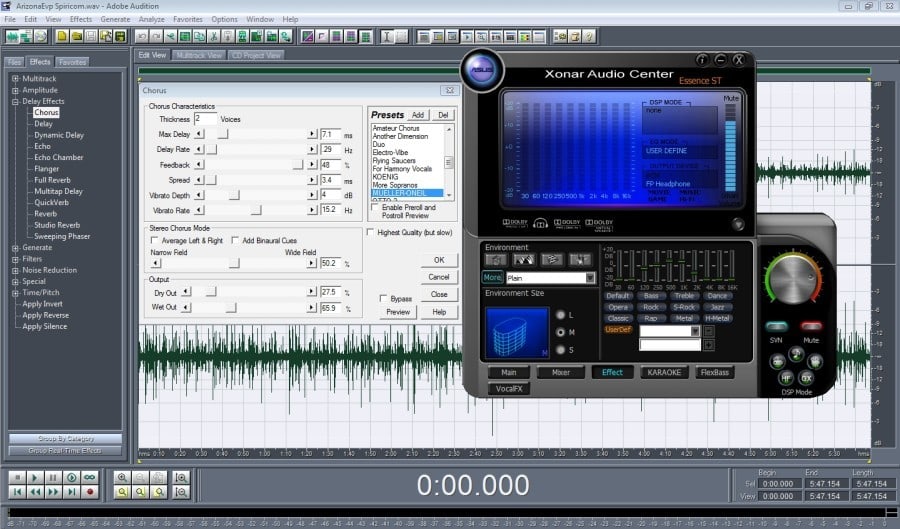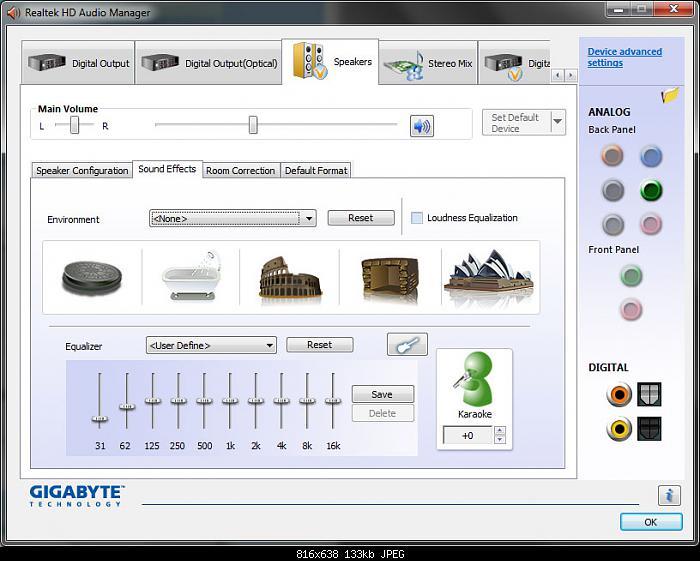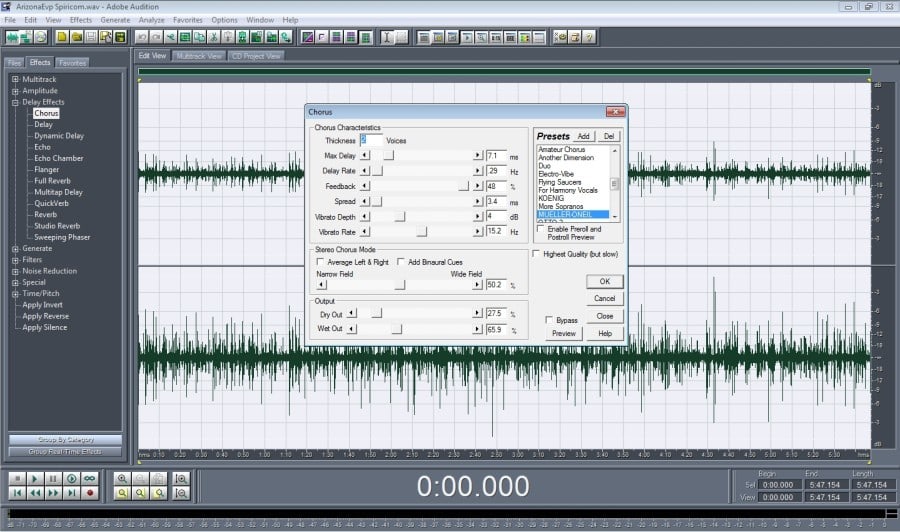by Ron Ruiz
Hi Guys. I created an audio file that seems to provide some two-way communication with the folks on the other side and would like to share the file and settings with you.
Side Note: The terms noise and sound are interchangeable for the purpose of this article.
The best audio experience relies on the Chorus filter of Audition along with Reverb – Equalizer and Key shifting; which can be found in the Audio Manager of a computer with multi-channel sound.
If you do not have Audition, I will provide a modified workaround. If you do not have a multi-channel audio output, the modified audio file will probably still work for you.
Background:
The trend in trans-dimensional communications has gone from traditional EVP to radio sweep devices like the hack shack & PSB-7. From there things evolved into the present incarnation of ghost boxes and various ghost apps for smartphones. All these methods, as well as traditional EVP, have been hit and miss with varying degrees of success and frustration.
In looking at the course of history, from Raudive to the Lamoreaux brothers to Meek to EVP Maker to the present, the lowest common denominator is; Audible Noise.
And from a noise perspective, regardless of whether you use Infrasound – Ultrasound – AM – FM – Short Wave – Microwave, etc…the audio output of the carrier signal must be converted to a level within the range of human hearing.
About 3 years ago I began a quest to try to find a suitable noise that could help responses from the other side come through a little better. I worked with the Chorus filter of Audition because I liked the slight delay the filter offered. Hundreds of noise variations from hundreds of sources were tried. Along the way I discovered that even micro lengths of sound less than half a second long could produce results, just not the result I was looking for.
Whether it was synchronicity or just dumb luck, last week I formulated a Spiricom-style audio file that seems rather promising.
Here are some examples:
Time indexes are approximate because the WordPress audio player is slightly off from my own player.
In this first clip I turn on the reverb and hear shout-outs at 9 and 11 seconds which prompted me to ask for confirmation. Keep listening till the end please.
In this second example I hold up an object and ask if they can identify it. The response rises up at the 10 second mark:
In this third clip I hold up another object. The response comes in twice at 12 & 13 seconds.
In the fourth example I decide to hold up some fingers. Listen at the 9 second mark.
In this last example, I ask if someone in particular is available to speak with me from the other side. For the first part a response is heard from 4 to 7 second. In the second half listen at the 14 second mark for the full name. There is also a confirmation at the end but it tapers off slightly.
Ready for the files and settings?
First off lets start with the baseline audio file. It is titled ArizonaEvp Spiricom Unmodified. I had to put it in a compressed zip folder so you’d be able to download it from this site. Click the link below to download and then extract the audio file:
If you have Audition…open the file ArizonaEvp Spiricom Unmodified.wav. From there you can double click or otherwise select the entire file – click the Effects Tab and then Expand Delay Effects. From there, Select Chorus and make your settings according to the pic below. Be sure to save these settings so you can use them again.
You can click the Preview Button to get an idea what the file sounds like.
If you have a multi-channel or HD audio output on your computer, you can create a dynamic soundscape that you can adjust to suit your unique hearing abilities.
In the following 2 pics are the sound settings I used to produce the audio output heard in the examples I posted. The first pic shows the Reverb and EQ Setting. The second pic shows the Key Shift setting which is at – 4 semitones.

 I have a separate sound card installed in my computer which is why my Audio Manager looks different from yours.
I have a separate sound card installed in my computer which is why my Audio Manager looks different from yours.
Here is a standard Audio Manager found in many desktop computers. On a PC, you can access the Audio Manager from the Control Panel.
 The environment menu is where you can choose your Reverb setting. The Equalizer is the EQ and the window below the Karaoke icon is where you can make Key Shift adjustments.
The environment menu is where you can choose your Reverb setting. The Equalizer is the EQ and the window below the Karaoke icon is where you can make Key Shift adjustments.
If you are having trouble seeing the pics, click the link below for a compressed zip folder with the full size images:
Audition and Audio Setting Pics
If you do not have Audition but you do have multi-channel audio on your computer…click the following link for a compressed zip folder which contains a Modified file which has the Audition Chorus setting already applied.
ArizonaEvp Modified With Audition
If you do not have a Audition or a multi-channel Audio Manager, you can try using either audio file with Audacity. There are ways to use Key Shifting in Audacity but I don’t know how to do it. Sorry.
If you try this experiment and find it useful, hop on over to the forum at our sister site: http://www.itcbridge.com/forum/ and leave a comment.
I don’t know how this file will work in a smartphone app that uses soundbanks, but you are more than welcome to give it a try.
Also, you are free to copy – redistribute – modify or mess with this file any way you want. All I ask is that you retain the name ArizonaEvp somewhere in the title. (nothing like a little shameless self-promotion eh)
Hopefully someone will come along and make this audio file even better 😉
Thank you for taking the time to read this and it is my sincere hope this audio experiment will work for you.
Take Care….Ron


